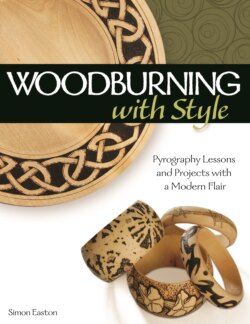Читать книгу Woodburning with Style - Simon Easton - Страница 44
На сайте Литреса книга снята с продажи.
The four essential nibs
ОглавлениеIt is not essential for a beginner to purchase every nib possible to get a satisfactory range of marks, and I would say experimentation with a few basic nibs produces a vast range of marks that are ultimately more rewarding. For the first year of my pyrography crafting, I used nothing more than basic pyrography wire shaped to suit my own requirements for each specific design. My top four essential nibs for beginners are a general writing nib, a spoon point nib, a broader shading nib, and a blade point or skew. With these four nibs alone, you are able to create a range of marks and lines. After experimenting with these four nibs, as I have done, you will also be able to learn what marks you particularly like and will use most frequently—you will then know how best to spend your money if you buy a specialist nib.
Writing nibs have a simple bent tip. Their usefulness lies in their versatility and the way they can be moved across the working surface. Writing nibs work well for drawing and making dots, spirals, lines, text, and other irregular lines and marks.
An example of some of the marks that can be made when you experiment with a writing nib.
The writing nib has a rounded end that allows it to move more fluidly over the surface in any number of directions, without digging in as a blade does.
An example of some of the marks that can be made when you experiment with a shading nib.
A spoon point is a versatile shading nib. The bowl allows for soft shading marks to be made while the edge can be used to make crisp lines.
An example of some of the marks that can be made when you experiment with a spoon point nib.
A spear shader can be used to shade in tight corners where other shading nibs might be too broad.
The skew is a typical bladed nib, ideally suited for crisp lines and fine marks.
An example of some of the marks that can be made when you experiment with a bladed nib.
Spoon points are very versatile nibs able to create both lines and shading effects over smaller areas. They are bowl-shaped as the name suggests. The soft underside of the bowl can be used for delicate shading and filling in areas of tone. The thin edge of the spoon can be used to make linear marks, and therefore is useful for cross-hatching and other similar effects. If used patiently and sensitively, it can be used to mark out sharp edges and to make softer areas with no edges at all.
Shading nibs are often broader in profile to cover as much surface area as possible with a minimum of effort. They may be shaped to resemble a spear, chisel, circle, or spade, or they may be formed using a coil of thinner metal to create a larger working point. They work very well for covering larger areas with tone and texture.
Blade points have a more defined straight edge and are used to create sharp lines and associated textures. They are good for creating detailed work, such as outlines, fine texture, particularly detailed designs, or lettering.
